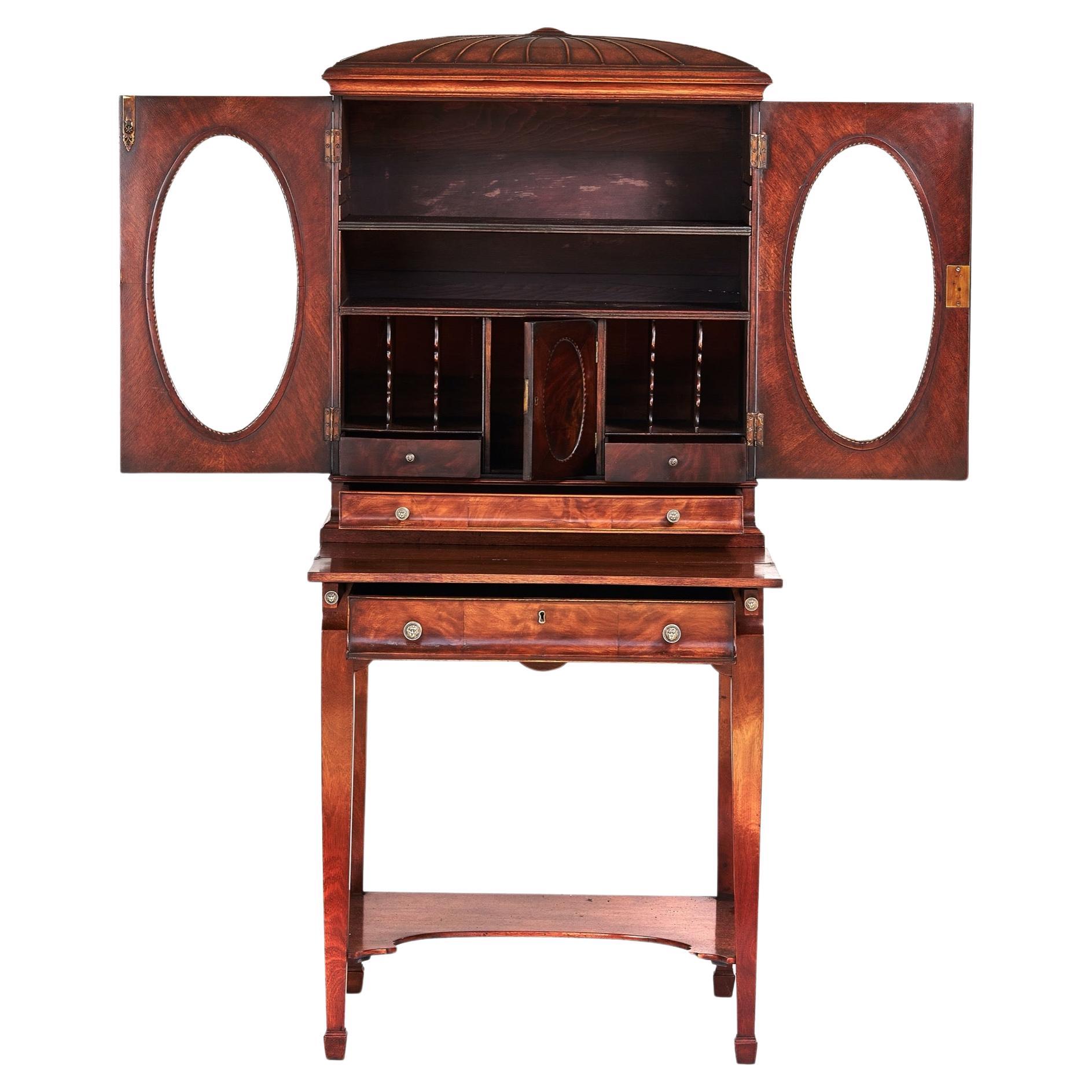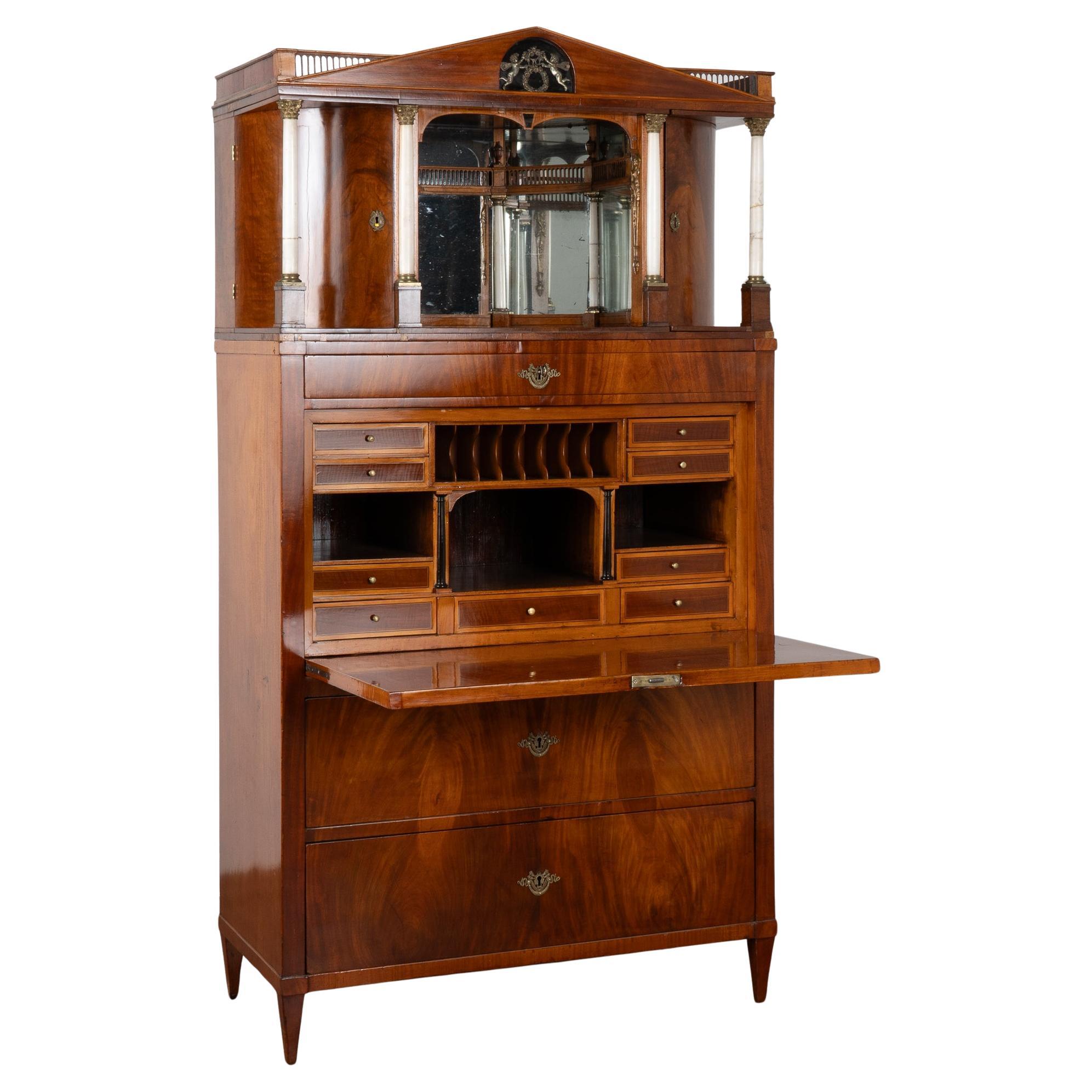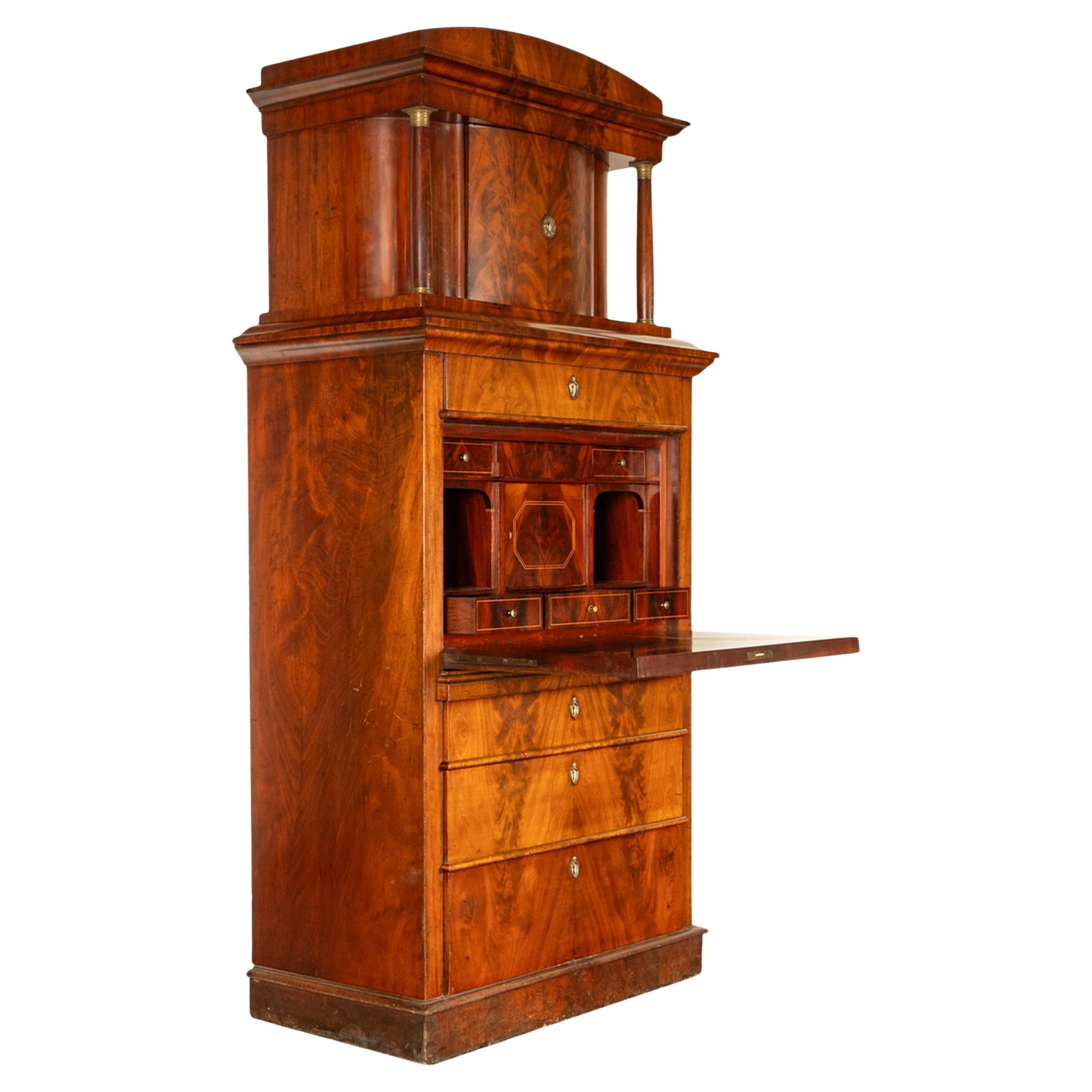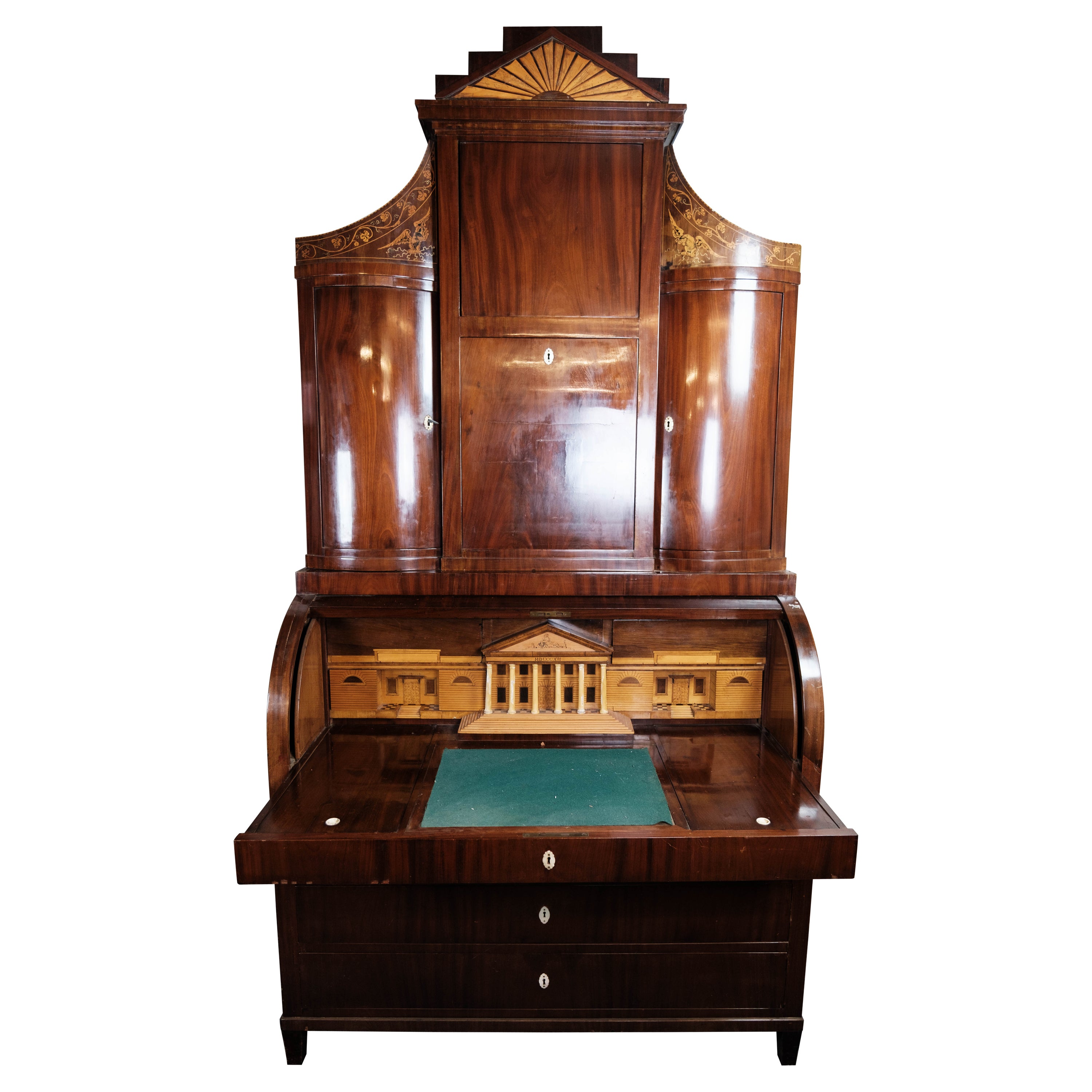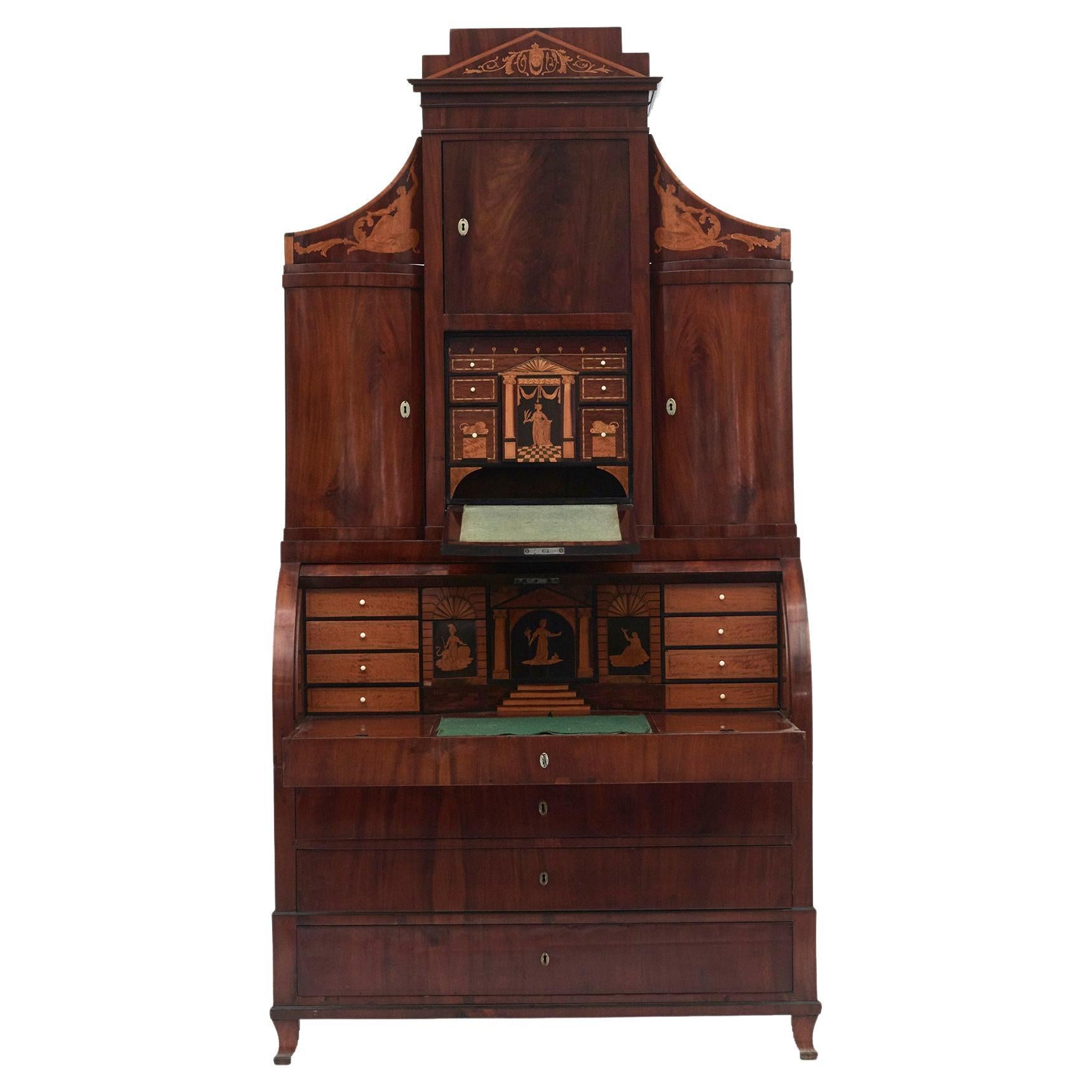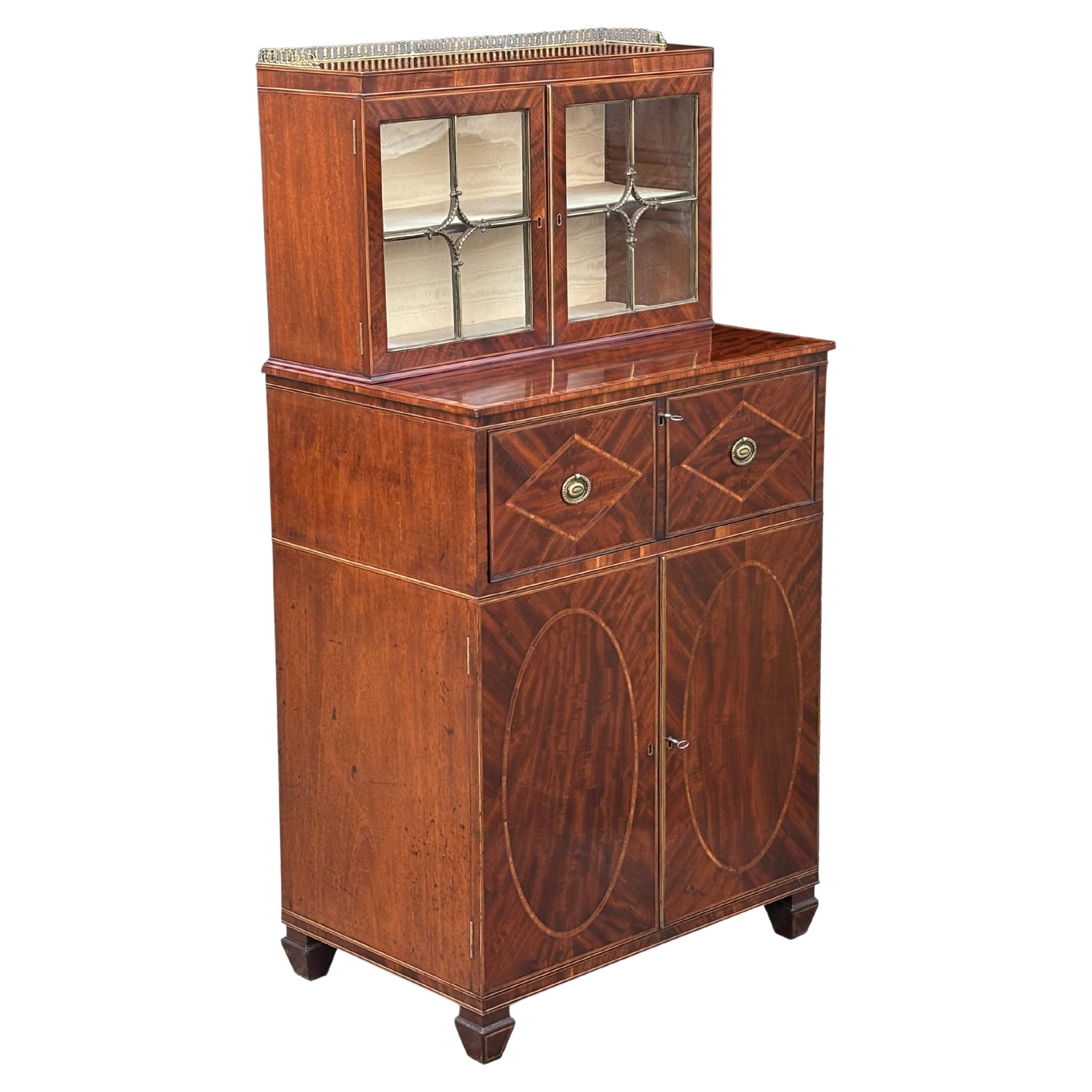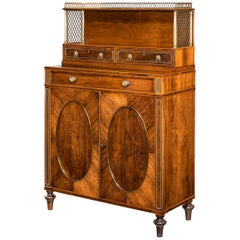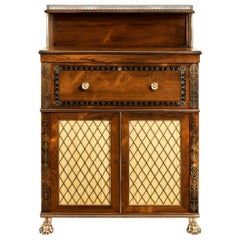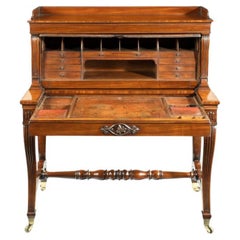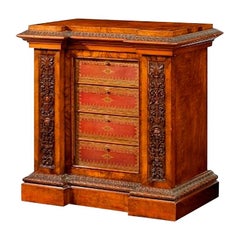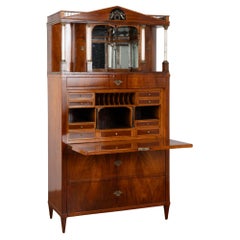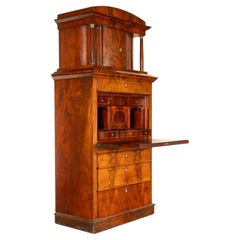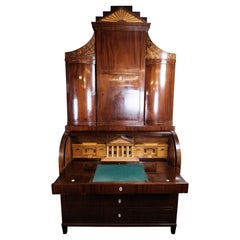Items Similar to Rosewood Regency Kneehole Bureau Cabinet Attributed to Seddon and Morel
Want more images or videos?
Request additional images or videos from the seller
1 of 14
Rosewood Regency Kneehole Bureau Cabinet Attributed to Seddon and Morel
$175,257.26
£127,500
€149,750.49
CA$244,433.05
A$264,781.47
CHF 139,418.20
MX$3,213,900.05
NOK 1,738,720.26
SEK 1,643,919.23
DKK 1,117,930.83
About the Item
An impressive and monumental rosewood Regency kneehole bureau cabinet with ormolu mounts of exceptional quality, attributed to Seddon and Morel, the central roll-top opening to reveal a fitted secretaire in satinwood with a sliding leather-inset reading slope, small drawers and ebony pigeon holes, all above two frieze drawers and cupboards with fabric-lined grilles, the upper section comprising four mirrored doors each enclosing an adjustable shelf and a scrolling cornice.
This extremely unusual piece of furniture can be thought of as a kneehole desk with a superstructure, a writing cabinet on a pedestal base or as a bureau cabinet with a kneehole section. Although examples of this kind of furniture were produced from the early 18th century onwards they are very rare and no designs for them seem to have survived in the usual design books. That may suggest that these pieces were not often produced for stock by cabinetmakers, rather they were bespoke pieces for specific clients and to suit particular spaces.
In practical terms, the design works extremely well, with the functions of several pieces of large furniture combining in one, thus allowing a considerable saving in floor space in a library or drawing room of the day.
What sets the current piece apart even further from the small number of other surviving examples is the use of exceptionally fine ormolu mounts, very much in the manner of Morel and Seddon. The firm of Morel and Seddon is most famous for the furniture produced for the King’s apartments at Windsor Castle during the 1820s. In fact, an ormolu-mounted door produced by the firm as part of this project, and illustrated on the front cover of Hugh Roberts’ ‘For the King’s Pleasure: The Furnishing and Decoration of George IV’s Apartments at Windsor Castle’ features very similar corner mounts to those used on the mirrored panels on our piece. In the case of the Seddon door, the direction of the mounts is reversed but they are certainly very similar in design and quality of execution.
- Attributed to:Morel & Seddon (Cabinetmaker)
- Dimensions:Height: 85 in (215.9 cm)Width: 72 in (182.88 cm)Depth: 36 in (91.44 cm)
- Style:Regency (In the Style Of)
- Materials and Techniques:
- Place of Origin:
- Period:
- Date of Manufacture:19th Century
- Condition:Wear consistent with age and use. exceptional quality.
- Seller Location:Lymington, GB
- Reference Number:1stDibs: LU973030731082
About the Seller
5.0
Recognized Seller
These prestigious sellers are industry leaders and represent the highest echelon for item quality and design.
Established in 1982
1stDibs seller since 2013
136 sales on 1stDibs
Typical response time: 2 hours
Associations
LAPADA - The Association of Arts & Antiques Dealers
- ShippingRetrieving quote...Shipping from: Lymington, United Kingdom
- Return Policy
Authenticity Guarantee
In the unlikely event there’s an issue with an item’s authenticity, contact us within 1 year for a full refund. DetailsMoney-Back Guarantee
If your item is not as described, is damaged in transit, or does not arrive, contact us within 7 days for a full refund. Details24-Hour Cancellation
You have a 24-hour grace period in which to reconsider your purchase, with no questions asked.Vetted Professional Sellers
Our world-class sellers must adhere to strict standards for service and quality, maintaining the integrity of our listings.Price-Match Guarantee
If you find that a seller listed the same item for a lower price elsewhere, we’ll match it.Trusted Global Delivery
Our best-in-class carrier network provides specialized shipping options worldwide, including custom delivery.More From This Seller
View AllRegency Rosewood Two-Door Side Cabinet, Attributed to John Mclean
By John Mclean
Located in Lymington, Hampshire
A fine high Regency rosewood two-door side cabinet, attributed to John Mclean, of upright rectangular form, the upper section comprising two small drawers ...
Category
Antique 1810s English Regency Cabinets
Materials
Rosewood
Regency Brass-Inlaid Rosewood Secretaire Cabinet
Located in Lymington, Hampshire
A Regency brass-inlaid rosewood secretaire cabinet, the rectangular top with a pierced galleried shelf with trellis work on the sides, above a secretaire drawer, banded with brass pa...
Category
Antique 1810s English Regency Cabinets
Materials
Brass
A George IV mahogany mechanical escritoire attributed to Gillows
Located in Lymington, Hampshire
A George IV mahogany mechanical escritoire attributed to Gillows, of rectangular form with a vertical superstructure on reeded cabriole legs with a turned stretcher and the original ...
Category
Antique 1820s English George IV Desks and Writing Tables
Materials
Brass
Victorian Walnut Library Cabinet
Located in Lymington, Hampshire
This walnut cabinet has a shaped, stepped top above a central glazed door enclosing four Moroccan leather drawers with cedar linings. Flanked by eight smaller disguised drawers, the ...
Category
Antique 1840s English Victorian Cabinets
Materials
Walnut
Victorian Satinwood Breakfront Side Cabinet Attributed to Dyer and Watts
Located in Lymington, Hampshire
A Victorian satinwood breakfront side cabinet with Wedgwood plaques attributed to Dyer and Watts, the shaped top above a central door flanked by two gla...
Category
Antique 19th Century English Victorian Cabinets
Materials
Ormolu
A Sheraton period West Indian satinwood secretaire bookcase
Located in Lymington, Hampshire
A Sheraton period West Indian satinwood secretaire bookcase, with later painted Victorian decoration and mirror backs, of tall rectangular form, the upper section with two doors of g...
Category
Antique 1790s English Sheraton Bookcases
Materials
Glass, Satinwood
You May Also Like
Fine Regency Style Mahogany Writing Cabinet Circa 1900
By Waring & Gillow
Located in Dereham, GB
Fine Regency Style Mahogany Writing Cabinet circa 1900
Semi dome shaped top with mould detail.
Top Section :
Pair Flamed Mahogany doors, with oval framed panels,
Working Lock & Ke...
Category
Antique Early 1900s British Adam Style Cabinets
Materials
Mahogany
$1,484 Sale Price
20% Off
Early 19th Century Mahogany Empire Secretary Bureau from Denmark
Located in Round Top, TX
Rich mahogany and stately lines define this handsome Empire drop front secretary.
Refer to close up photos to appreciate the stunning color and pattern of the mahogany veneer.
Multip...
Category
Antique Early 19th Century Danish Empire Secretaires
Materials
Brass
Antique Austrian Biedermeier Mahogany Secretary Desk Tabernacle Cabinet 1820
Located in Portland, OR
A fine, elegant, antique Austrian mahogany Biedermeier secretary desk cabinet, circa 1820.
The cabinet in two sections, the top with a curved architectural pediment, below is a curved door tabernacle cupboard, flanked by a pair of columns with gilt bronze bases and capitals. The base with a series of four graduated drawers with shield shaped lock-plate escutcheons inlaid with bone, to the center is a fall front writing surface enclosing a fitted interior with a series of drawers, pigeon holes and a central locking door, the doors and drawers are inlaid with satinwood stringing. All the locks are fully operational and keys are present.
The cabinet is raised upon a plinth base, the secretary cabinet is made from the finest figured Cuban mahogany, condition is very good, no condition issues or restoration. This very elegant Biedermeier secretary cabinet...
Category
Antique 1820s Austrian Biedermeier Secretaires
Materials
Ormolu
Large Empire Bureau Of Hand Polished Mahogany With Inlaid Wood from 1820s
Located in Lejre, DK
This grand Empire bureau is a testament to the exquisite craftsmanship of the 1820s, crafted from hand-polished mahogany adorned with intricate inlaid wood detailing. Its imposing pr...
Category
Antique 1820s Danish Empire Secretaires
Materials
Mahogany
Danish Late Empire Mahogany With Inlay Bureau / Secretair
Located in Kastrup, DK
Rare Danish early 19th century secretary or slant front bureau.
Exquisitely crafted from mahogany with fabulous marquetry decoration in black n...
Category
Antique Early 19th Century Danish Empire Secretaires
Materials
Bone, Mahogany, Satinwood, Walnut
$10,022 Sale Price
20% Off
Early 19th Century Regency Period Mahogany Secretaire Bookcase
Located in Petworth,West Sussex, GB
An exceptional fine early 19th century, Regency period brass, mahogany, satinwood and boxwood inlay secretaire bookcase. The upper section with a surmounted by an ornate fretted bras...
Category
Antique Early 19th Century British Regency Bookcases
Materials
Satinwood
More Ways To Browse
Antique Bureau Cabinet
Antique Writing Cabinet
Windsor Castle
Kneehole Desks
Roll Top Desks
19th Century Roll Top Desk
Rosewood Bureaus
Antique Rosewood Bureau
Frieze Fabric
Morel And Seddon
Ico Parisi Gio Ponti
Wood 2 Door Cabinet
Antique Glass Panel Door
Metal Slide
Vintage Colonial Cabinets
18th Century Glass Display Cabinet
Beveled Glass Cabinet
Bronze Mirrored Cabinet
